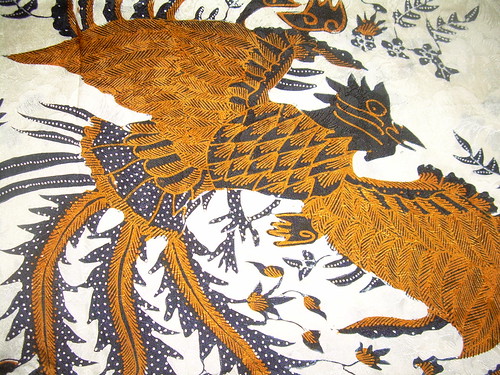 Last year, UNESCO recognized batik as world Masterpiece of Oral and Intangible Heritage of Humanity from Indonesia. This traditional piece of cloth painted with colorful pattern is full of life philosophy. Almost every region in Java and Sumatera Island has different type of batik. Cirebon, a city in the northern coast of Java also has its own specialty.
Last year, UNESCO recognized batik as world Masterpiece of Oral and Intangible Heritage of Humanity from Indonesia. This traditional piece of cloth painted with colorful pattern is full of life philosophy. Almost every region in Java and Sumatera Island has different type of batik. Cirebon, a city in the northern coast of Java also has its own specialty.
What is Batik?
The word batik is thought to be derived from the word 'ambatik' which translated means 'a cloth with little dots'. The suffix 'tik' means little dot, drop, point or to make dots. Batik may also originate from the Javanese word 'tritik' which describes a resist process for dying where the patterns are reserved on the textiles by tying and sewing areas prior to dying, similar to tie dye techniques. Another Javanese phase for the mystical experience of making batik is “mbatik manah” which means "drawing a batik design on the heart".
In the past, Indonesians, mostly adults, wear batik only at formal events. Nowadays it has become increasingly popular even among the younger generation with batik factories starting to manufacture more wearer-friendly and fashionable batik outfits.
Many office workers now wear batik on a daily basis, while local designers compete to produce more attractive designs.
While batik originated in Javanese courts, several other regions in Indonesia also have their own styles of batik. The fabric is also widely worn in countries such as Malaysia, Singapore and Thailand. Cloth painting in this fashion originated in the 9th century in Central Java. For centuries, only members of royal families can wear this beautifully painted cloth. However, it then became public fashion and spread all over Java and Sumatra Island.
Batik patterns are divided into two big groups, the royal and coastal motifs. The royal motifs are dominated with brown, dark brown, black, brownish red, yellowish brown or white color and the painting must adhere to some approved philosophical pattern that had not changed for centuries. This kind of batik usually wore on formal occasion or by royal families. The second group, the coastal motifs are more colorful with playful natural pictures.
Cirebon’s Batik
Local batik production in Cirebon is centralized in Trusmi, a village 5kms from the city centre. Around 1000 batik artist work in or around the village. Trusmi Batik is mostly coastal styled, although some royal motifs are also available as there are 4 kingdoms in Cirebon that still exist to date. One of the most famous royal motifs is the “Singa Wadas” that describe a worshipped royal lion (singa means lion in local language).
Like any other coastal batik, the motif of Trusmi batik is heavily influenced by sari, India’s traditional cloth brought by trader and also by some pattern introduced by the Dutch during the colonial era and the Chinese. Chinese influence are shown by the appearance of pictures of dragons, and some creature from Chinese mythology such as phoenix and qilin, a quardian lion.
http://www.visitbandung.net/arts/trusmi-batik-the-legacy-of-cirebon-culture.html
No comments:
Post a Comment